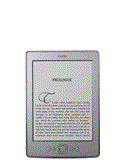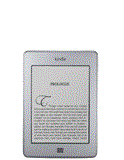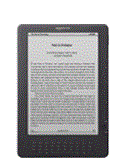Ok, I’ll come right out and admit that I’m a big fan of the Kindle DX. I know it is a bit expensive compared to the other Kindles, especially after the price drops that we have just experienced, but it does a specific task very well and shouldn’t be overlooked entirely by prospective purchasers. Unfortunately, Amazon seems to have virtually abandoned the only good large form eReader on the market at the moment, at least as far as their advertising is concerned.
Since I do feel rather strongly that there are uses for this Kindle yet, and that many people would find it worth the money, let’s take a look at the factors that weigh your choices when looking into a new purchase. Here are some of the more important specs that differentiate the Kindle DX against its newer siblings:
| Kindle 4 | Kindle Touch | Kindle DX | |
 |
 |
 |
|
| Display | 6″ E INK Pearl | 6″ E INK Pearl Touchscreen | 9.7″ E INK Pearl |
| Connectivity | WiFi | WiFi + Optional 3G | 3G |
| Battery Life | 1 Month | 2 Months | 3 Weeks |
| Weight | 5.98 Ounces | 7.5 – 7.8 Ounces | 18.9 Ounces |
| Storage | 2GB (1,400 Books) | 4GB (3,000 Books) | 4GB (3,500 Books) |
| Price | $79 | $99 – $149 | $379 |
Kindle 4
Pros:
This new Kindle is the least expensive and most portable ever to hit the shelves. It weighs less than most paperback books, for example, and will technically fit in your pocket. Please note that for the safety of your Kindle it is not recommended that you carry your Kindle around in a pocket. The battery life, while not quite as impressive as the more expensive Kindle Touch, is still an impressive month of reading. You can even change the language of the Kindle interface now, should you have a non-English preference.
Cons:
The Kindle 4’s inability to be purchased with 3G connectivity makes it a potentially poor choice for people without access to a reliable wireless network. Storage is also substantially reduced, which might be an issue for people with large libraries. This may not matter to many, however, because this Kindle also lacks the ability to play audiobooks, or indeed any form of audio. If you like to listen to music while you read or have plans to make use of the Kindle line’s popular Text to Speech feature, this is not the right device.
Kindle Touch
Pros:
The first ever Kindle with a touchscreen, the Kindle Touch eliminates the uncomfortable keyboard that many people have often complained was simply wasted space on their eReader. This manages to reduce the weight, allows for an easily usable localized interface, and generally speeds up navigation. This particular Kindle also has access to the X-Ray feature, which will allow readers to highlight connected passages throughout a given book, find term repetitions, locate external references, and pull up detailed articles via Wikipedia. So far, no other member of the product line has access to that. You will also get the device with the highest battery life in this comparison as well as the opportunity to choose 3G coverage in addition to the included WiFi capabilities. Unlike the Kindle 4, this eReader has audio capabilities and will be able to both play audio files or audiobooks and read texts aloud for you using the Text to Speech feature.
Cons:
While Amazon has made the Kindle Touch’s interface quite simple to use while reading, it is still completely lacking in physical page turn buttons. This will make a small difference in how you hold the device and how often the screen needs to be cleaned. It is also slightly more expensive than the Kindle 4, though still coming in just under the $100 mark if you make use of the cheapest options. Aside from that, the only real downside is the highly restricted nature of the optional 3G coverage. Unlike previous Kindles, this one will only allow users to browse the Kindle Store and Wikipedia via 3G. Everything else is blocked off, rendering that option far less appealing.
Kindle DX
Pros:
The clearest advantage here is going to be screen size. Having a 9.7″ screen to work with will come in very handy for just about any book. This is especially important for people who prefer or require larger print sizes, or for the display of standard size PDF files that might be difficult to view on smaller devices. The Kindle DX has slightly more available storage space than either of the other options, which is also useful for PDF viewing as those files tend to be far larger than Amazon’s proprietary format. Also, this is the only device listed here that allows unrestricted 3G connectivity. Of all products in the Kindle line, the DX is probably the best suited for internet browsing.
Cons:
The biggest downside here is weight. The Kindle DX is clearly far too heavy for comfortable long-term reading if you prefer to hold your book in one hand. It is better compared to a hardcover book, which has a bit more heft. Perhaps owing to the assumption that people would not want to be reading with just one hand anyway, there are no left-side navigation controls. This can make the device hard to use, especially for lefties. The firmware for the DX is also lagging a bit behind and shows no signs of pending improvements, so what you have now is probably all you’re going to get. Finally, obviously, is the price. At nearly four times the cost of the Kindle Touch, the DX will only be worthwhile if its larger screen provides you with something you find truly valuable.
Recommendations
Kindle 4: Perfect as a paperback replacement for the regular reader. The stripped down model provides a cheap enjoyable reading experience.
Kindle Touch: Great for active readers. By far the best option if you like to highlight, annotate, and examine your reading material closely.
Kindle DX: The larger screen makes this desirable for people preferring large print, anybody carrying around loads of PDF files, students, and those with a strong preference for the hardcover feel of a book.
I am very disappointed that they haven’t done a DX refresh or reduction in price. $200 would make me a buyer. I want it for large format books (ie., tech books). The little Kindles just aren’t big enough for diagrams, etc. Of course, a colour Kindle DX (eInk I mean) for $400 would make a buyer out of me, too.
Screen size is a must for me. Weight it is not an issue if you takeoff the cover. Because I interact with my PC where I keep my ebooks, space also is not something thatI look into.
There is not an easy way to novigate thru a lot of files in the DX I do not use it for that too.
Mostly for reading a big screen and not that many gizmos that distract from the main pourpose.
eInk or Pearl is also a good choice. I also have ipad and I am not sure that for reading touchpad is a necesity.
If I could get a DX with wifi and current (i.e. kindle 4) software I would buy it at the current price right now to replace my current (original, non-perl screen) DX
but just the screen update, with no other changes, isn’t worth the price for a replacment.
As Carlos mentions, there are a lot of things that work _much_ better when reading on the larger screen, .pdf files with multiple columns are small, but still readable, on a 9.7″ screen, but on a 6″ screen you end up needing to scroll back and forth to read the text.
I wonder if Amazon improved the screen of Kindle Touch. Too many sad stories I have heard about Kindle 3’s easily broken screen…
Why continue to ignore the Kindle Keyboard? It might be a little more expensive, but has some useful features – eg working with the integrated dictionary, which has very good coverage of older words. And you don’t have to wave your arms around to control it!